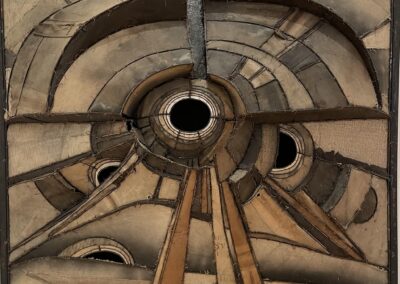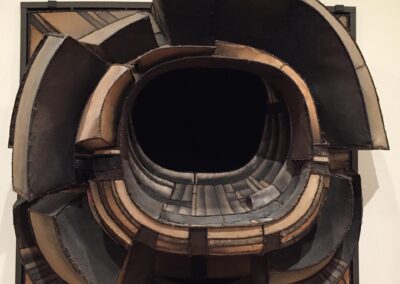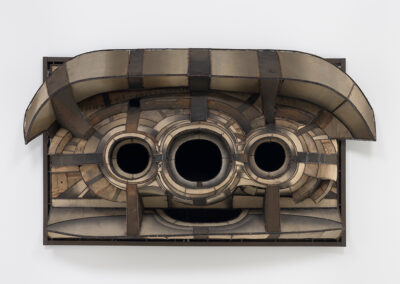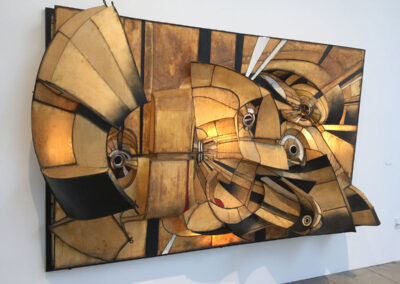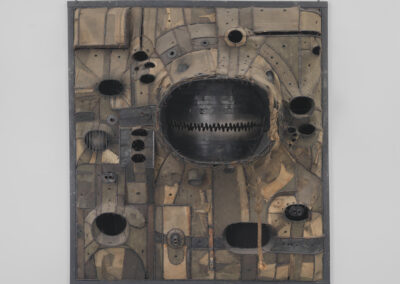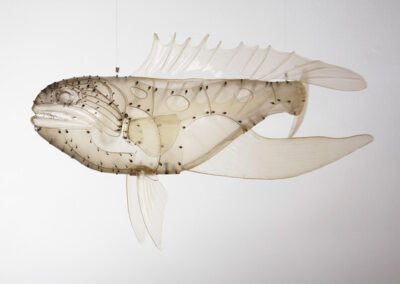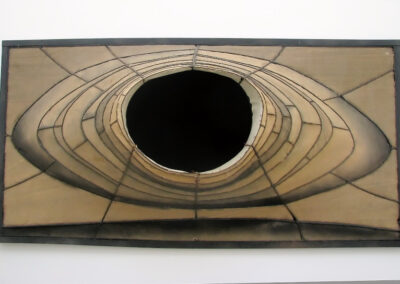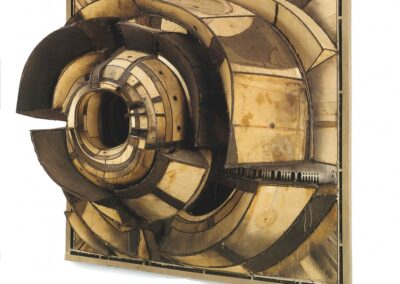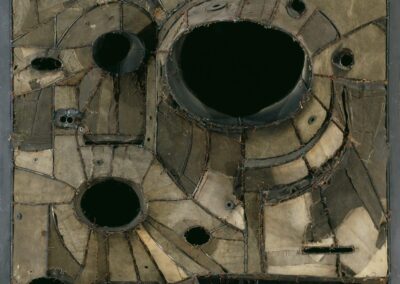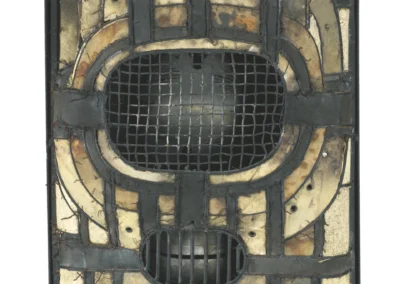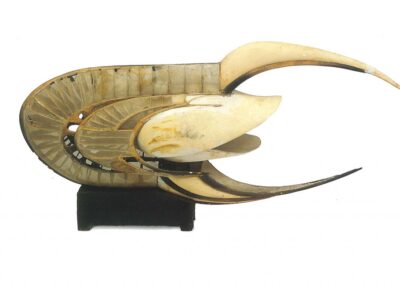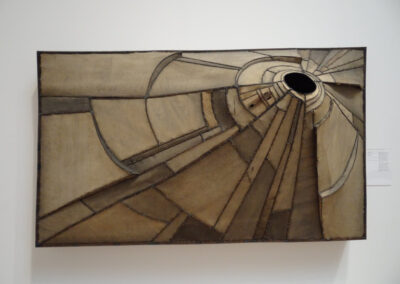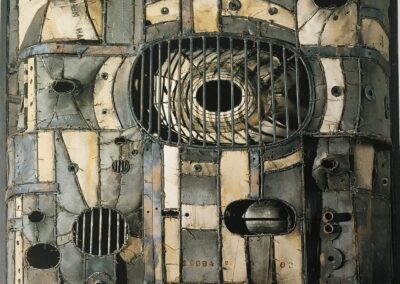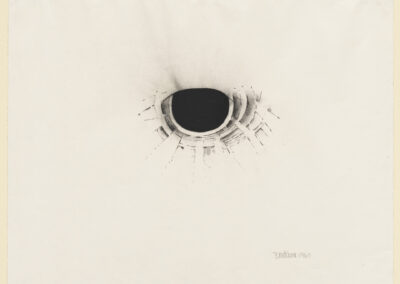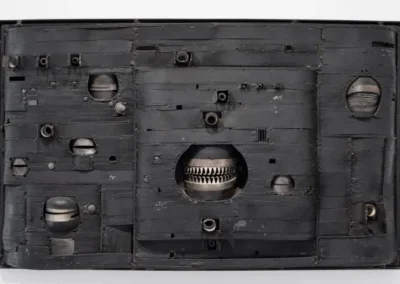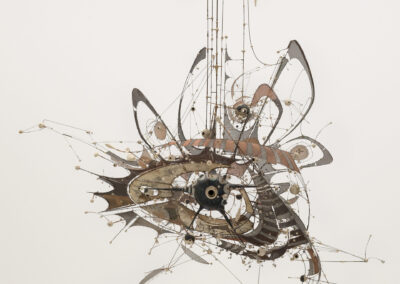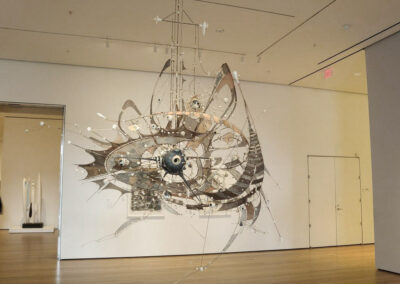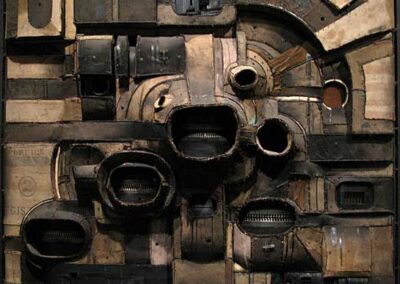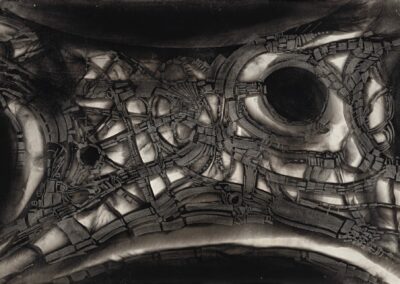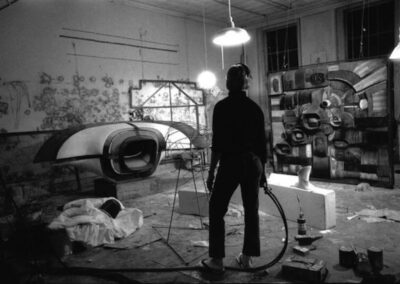The next Artist You Need To Know is Lee Bontecou (1931 – 2022).
Bontecou was a groundbreaking American artist primarily situated in the art community of New York City. Her works are immediately recognizable : her abstract sculptures (her most prolific period was in the 1960s and 1970s) were primarily vacuum-formed plastic wall works that straddled sculpture, painting and drawing with a distinct industrial aesthetic.
Her artworks elude any simplistic or ‘easy’ label : Bontecou’s objects employ aspects – and share ideas with – Minimalism, Abstract Expressionism and even some Cubist notions, but “her sculptures are typically defined by dark cavernous voids at their centers, and posses an industrial, seemingly mechanical aesthetic.” (from Sotheby’s)
“My concern is to build things that express our relation to this country . . . to other worlds to glimpse some of the fear, hope, ugliness, beauty, and mystery that exists in us all and which hangs over all the young people today.”
Bontecou was born in Providence in 1931 : she studied at the Art Students League in New York (1952 to 1955) and the Skowhegan School for Painting and Sculpture in Maine (1954). She was awarded a Fulbright scholarship from the U.S.-Italy Fulbright Commission and would study in Rome (1957-1958).
Her parents were both active in the American war work / industry in the 1940s during World War II (her father was part of a team that developed the aluminum canoe and her mother wired submarine parts), and this had a lasting impact on both Bontecou’s ideas, the media she employed and her aesthetic. This “informed the synthesis of technology, industrial engineering and the natural world in her later sculptures. Her innovative use of unconventional materials including saw blades or metal tubing was never arbitrary; she placed these surprising objects in contrast with scattered soot or organic cloth to juxtapose industrial and natural materials. She developed a process in the 1950s of producing carbon spray from an oxy-acetylene torch for a prototypical airbrushed effect which she applied to the surface of her sculptures, producing a glowing, almost living quality to her frightening yet welcoming works.” (from here)
Bontecou was one of the major American artists who were part of the stable of artists with the Leo Castelli Gallery in New York City during the 1960s (which included Robert Rauschenberg, Frank Stella and Jasper Johns). She is appropriately included among this group that was one of the most exciting and innovative periods in art history, and definitely American art.
The renowned artist and critic Donald Judd once praised her in saying that “Bontecou [has made] her work so strong and material that it can only assert itself….it is credible and awesome.”
“My most persistently recurring thought is to work in a scope as far-reaching as possible, to express a feeling of freedom in all its necessary ramifications—its awe, beauty, magnitude, horror, and baseness. This feeling embraces ancient, present, and future worlds: from caves to jet engines, landscapes to outer space, from visible nature to the inner eye.”
Her major period of production was from 1959 to 1967 : while drawing on her childhood memories of her parents’ work, Bontecou also was informed by contemporary events of that period, often listening to the radio as she worked. Thus, her sculptures are of their time, within the milieu of the Cold war and global unrest, while also drawing from the stories of the Holocaust in WW II. Bontecou was also a well respected figure in the Feminist Art Movement of the 1970s in the United States.
From here : “She evoked the dread associated with such events by stretching scraps of soiled canvas over a welded steel armature, which she connected with copper wire. Each incorporates one or more deeply mysterious cavities. While these wall sculptures resemble quilts, landscapes, or stained glass, many are left untitled to avoid limiting the viewer’s individual response and interpretation.”
“She’s drawing with metal, she’s painting with canvas. One of the things she pioneered was to get sculpture off the ground, to make something that was neither a painting nor a sculpture, but something in between.” (Elizabeth Smith, MOCA)
Bontecou began teaching at Brooklyn College in 1971 and would be an educator in the Fine Arts Department for two decades. In the 1980s she relocated to Pennsylvania and continued to teach at various institutions in that state.
Her work can be found in numerous collections. These include the Museum of Modern Art, New York; the Cleveland Museum of Art; Kunstmuseum Den Haag (The Hague); the National Gallery, Washington D.C.; the Menil Collection, Houston; the Walker Art Center, Minneapolis; Honolulu Museum of Art; Museum of Contemporary Art, Chicago; Smithsonian American Art Museum; Stedelijk Museum Amsterdam; University of Michigan Museum of Art; Walker Art Center and the Whitney Museum of American Art, New York.
Bontecou has also installed her impressive works in many public sites, especially in institutional space, such as the David Winton Bell Gallery at Brown University, and the David H. Koch Theater at Lincoln Center.
She was recognized with the Louis Comfort Tiffany Award in 1959 and in 2004 she was elected to the National Academy of Design. In 2004 the Museum of Modern Art in New York mounted a massive retrospective of her work.
Bontecou died in Florida in 2022 when she was 91 : a fine obituary can be read here. Much more about her life, art and impact can be enjoyed here. A short video from the MOMA about Bontecou can be seen here.
The last image in the series we’ve shared below (by Ugo Mulas) was used as the cover art for the band Spoon’s 2007 album Ga Ga Ga Ga Ga : and we’ve shared these ‘studio’ images to give a more genuine sense of the scale and power of Bontecou’s artwork.
“Since my early years until now, the natural world and its visual wonders and horrors – man-made devices and their mind-boggling engineering feats and destructive abominations, elusive human nature and its multiple ramifications from the sublime to unbelievable abhorrences – to me are all one. It is in the spirit of this feeling that the primary influences of my work have occurred.”

